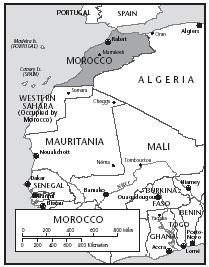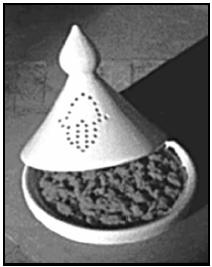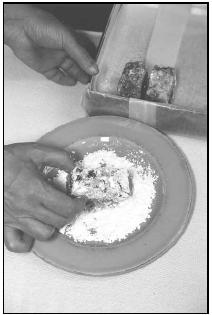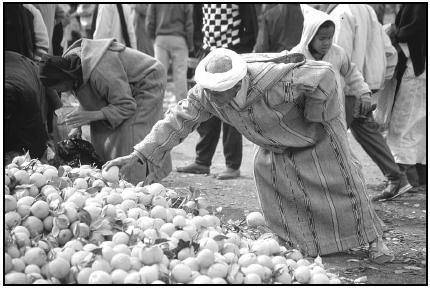Morocco
Recipes

1 GEOGRAPHIC SETTING AND ENVIRONMENT
Morocco is located in the northwestern corner of Africa. Morocco is slightly larger in area than California, and its territory has three different regions. The northern coast along the Mediterranean Sea is made up of fertile land that rises to elevations of about 8,000 feet (2,400 meters). The Atlas Mountains run between the Atlantic coast in the southwest to the Mediterranean Sea in the northeast. Finally, the semiarid area in the south and east known as the Western Sahara connects Morocco with the vast African Sahara Desert.
Morocco faces a problem with desertification. Desertification is the process where fertile land becomes barren and desert-like. Desertification may be caused by forces of nature, such as lack of rainfall or drought. Humans contribute to desertification when they clear away all the trees or allow their livestock to graze too much so that they eat away all plants. These practices leave no plants to hold the soil in place, so wind and rain can carry away the fertile topsoil. Morocco also has a problem with water pollution from oil spills, poor sewage treatment practices, and the use of strong pesticides.
In the northwest, agriculture in Morocco thrives. Except in years when there is severe drought, Moroccan farmers are able to supply the country with enough food.
2 HISTORY AND FOOD
Nomads called Berbers were the first inhabitants of Morocco over two thousand years ago. They used local ingredients, such as olives, figs, and dates, to prepare lamb and poultry stews. Over time, traders and conquering nations introduced new food customs. Among them were the Phoenicians, Carthaginians, and Romans. However, the strongest influence on native cooking was the Arab invasion in the seventh century A.D.
The Arabs brought with them new breads and other foods made from grains. They

3 FOODS OF THE MOROCCANS
Morocco, unlike most other African countries, produces all the food it needs to feed its people. Its many home-grown fruits and vegetables include oranges, melons, tomatoes, sweet and hot peppers, and potatoes. Five more native products that are especially important in Moroccan cooking are lemons, olives, figs, dates, and almonds. Located on the coast of the Mediterranean Sea, the country is rich in fish and seafood. Beef is not plentiful, so meals are usually built around lamb or poultry.
Flat, round Moroccan bread is eaten at every meal. The Moroccan national dish is the tajine, a lamb or poultry stew. Other common ingredients may include almonds, hard-boiled eggs, prunes, lemons, tomatoes, and other vegetables. The tajine, like other Moroccan dishes, is known for its distinctive flavoring, which comes from spices including saffron, cumin, coriander, cinnamon, ginger, and ground red pepper. The tajine's name is taken from the distinctive earthenware dish with a cone-shaped top in which it is cooked and served. Another Moroccan dietary staple is couscous, made from fine grains of a wheat product called semolina. It is served many different ways, with vegetables, meat, or seafood.
Sweets play a very important role in the Moroccan diet. Every household has a supply of homemade sweet desserts made from almonds, honey, and other ingredients. Mint tea is served with every meal in Morocco. It is sweetened while it is still in the pot.
Chicken Tajine with Almonds and Prunes
Ingredients
- 6 skinless, boneless chicken breasts
- 2 Tablespoons olive oil
- 1 teaspoon salt
- ½ teaspoon ground black pepper
- 1 teaspoon powdered cinnamon
- ¼ teaspoon powdered ginger
- ½ teaspoon powdered saffron (optional)
- 3 short cinnamon sticks
- 4 ounces butter
- 2 large onions
- ½ cup sugar
- 1 strip lemon peel
- 1 pound dried prunes
- Blanched almonds
- Fresh watercress or mint
Procedure
- Combine the oil and ground spices in a large bowl.
- Cut the chicken into cubes and chop the onion finely. Put the chicken and onion into the bowl with the oil and spices. Combine well and let stand for 30 minutes.
- Melt the butter in a large skillet. Add the chicken, searing (browning) them lightly on all sides.
- Add any remaining marinade and enough water to cover. Simmer until chicken is tender (about 30 minutes).
- While the chicken is cooking, put the prunes in a small saucepan, cover with water and bring the water to a bowl. Remove the pan from the heat and let them stand for 20 minutes.
- Drain the prunes, return them to the pan, and ladle a little liquid from the meat pan over the prunes. Simmer the prunes for 5 minutes.
- Add the lemon peel, cinnamon sticks, and half the sugar to the prunes.
- Stir the remaining sugar into the meat.
- Arrange the meat on a serving platter. Add the prunes to the meat, and pour the sauce from the prunes over the meat and prunes.
- Boil the remaining liquid from the meat rapidly to reduce it by half and pour over the meat and prunes.
- Melt a small amount of butter in a saucepan and brown the almonds lightly. Garnish the tajine with the almonds and watercress or mint.
- Serve with rice or couscous.
Serves 10 to 12.

Moroccan Mint Tea
Ingredients
- 1½ Tablespoons green tea (or 2 teabags of green tea)
- Boiling water
- 3 Tablespoons sugar (or to taste)
- Handful (about 2 Tablespoons) of fresh or dried spearmint leaves
Procedure
- Put the tea in a 2-pint teapot and fill it with boiling water.
- Let the tea steep (soak) for 2 minutes.
- Add mint leaves and sugar to taste.
4 FOOD FOR RELIGIOUS AND HOLIDAY CELEBRATIONS
Muslim dietary restrictions prohibit the consumption of pork and alcohol. During the holy season of Ramadan, when Muslims fast during the day, a thick soup called harira is served at night. A bowl of harira, which is made with beans and lamb, is served with fresh dates. It is served both at home and in cafes. For the holiday Eid al-Fitr, which marks the end of Ramadan, a holiday feast is prepared. A popular dish at this feast is bisteeya, made with pigeon meat wrapped in pastry dough. More than 100 layers of pastry dough may be used.
The Muslim feast day of Eid el Kebir takes place seventy days after Ramadan. For this holiday, a sheep is roasted on a spit and served whole at the table. Each person cuts off a piece and dips it into a dish of cumin. Rich date bars called mescouta are a popular dessert at many festive occasions.
Holiday Menus
I.
Cashew bisteeya (pie made with phyllo dough)
Couscous with fennel
Mhalbi (custard)
Fresh seasonal fruit and dates
Mint tea
II.
Assortment of salads
Tajine of potatoes, peas, and artichoke hearts
Couscous
Dates stuffed with almond paste
Fresh seasonal fruit
Mint tea
Mescouta (Date Cookies)
Ingredients
- 6 eggs, well beaten
- ½ cup sugar
- 1 teaspoon vanilla extract
- ½ cup (1 stick) melted butter or margarine
- ¾ cup flour
- ½ teaspoon baking powder
- 1 cup pitted dates, chopped
- ½ cup walnuts or almonds, finely chopped
- ⅓ cup raisins, seedless
- 3 Tablespoons confectioners' sugar
Procedure
- Preheat oven to 350°F.
- In large mixing bowl, mix eggs, sugar, vanilla, and melted butter or margarine by hand (or with an electric mixer) until well-blended (mix for about 3 minutes).
- Gradually stir in flour and baking powder, a little at a time, stirring with a wooden spoon to blend.
- Add dates, nuts, and raisins, and mix well.
- Pour mixture into greased 8- or 9-inch square cake pan.
- Bake for about 30 minutes, or until a toothpick inserted in the center comes out clean.
- While still warm, cut into rectangular bars about an inch wide.
- Put 3 Tablespoons confectioners' sugar into a small dish.
- Roll each bar in confectioners' sugar.
- Store bars in a box with wax paper between layers.
Makes 24 to 30 bars.

Bisteeya
Ingredients
- 2 Tablespoons vegetable oil
- 3 cloves garlic, crushed, or 1 teaspoon garlic granules
- 2 large onions, grated
- ½ cup almonds, sliced
- 1 cup fresh parsley, finely-chopped or ½ cup dried parsley flakes
- 2 teaspoons ginger, ground
- 3 teaspoons cinnamon, ground, or more as needed
- 5 cups boneless, skinless chicken, cooked and cut into bite-size chunks
- Salt and pepper to taste
- 1 cup butter or margarine, more or less as needed
- 5 eggs, beaten until frothy
- ¼ cup sugar
- 1 pound package frozen phyllo dough (available in freezer section of most supermarkets), thawed according to directions on package
- 2 teaspoons confectioners' sugar, more or less as needed

Procedure
- In large skillet, heat oil over medium-high heat.
- Add garlic, onions, almonds, parsley, ginger, and 2 teaspoons cinnamon. Stirring constantly, fry until onions are soft, about 3 minutes.
- Remove from heat, add cooked chicken and salt and pepper to taste, and stir well. Set aside.
- Melt 2 Tablespoons butter or margarine in medium skillet over medium heat.
- Add eggs, sugar, and 1 teaspoon ground cinnamon, and stir well.
- Adding more butter or margarine if necessary to prevent sticking, stir constantly until eggs are soft scrambled, about 5 minutes.
- Add to chicken mixture and lightly toss together.
- Preheat oven to 350°F.
- Melt ½ cup butter or margarine in small saucepan.
- Brush bottom and sides of pie pan with melted butter or margarine.
- Remove sheets of phyllo from package and unfold; keep covered with clean, dampened paper towel.
- Center one phyllo sheet in buttered pie pan and gently press into the pan, leaving a generous overhang all around the top edge.
- Brush the first sheet with plenty of melted butter or margarine.
- Layer 5 more sheets of phyllo dough, brushing each one with melted butter or margarine.
- Fill crust with chicken mixture and cover with 3 more layers of phyllo, brushing each with butter or margarine.
- Roll overhanging edges together and tuck inside of pie pan rim.
- Brush top and edges with the remaining melted butter or margarine.
- Using fork, poke about 8 steam vents into top of crust.
- Bake in oven for about 20 minutes or until golden brown.
- Remove from oven and sprinkle top with confectioners' sugar and cinnamon.
Serves 6 to 8.
Harira
Ingredients
- 4 Tablespoons olive oil
- 1 large onion, finely chopped
- 2 cloves garlic, crushed
- 1 teaspoon turmeric
- 1 teaspoon ginger, ground
- 1 teaspoon cumin, ground
- 3 cans (approximately 6 cups) chicken or vegetable broth
- 8 ounces (1¼ cups) green lentils, washed
- 1 14-ounce can chopped tomatoes
- 1 15-ounce can chickpeas, drained
- 3 Tablespoons fresh cilantro, chopped
- 3 Tablespoons fresh parsley, chopped
- Salt and freshly-ground black pepper
- Lemon juice (optional)
Procedure
- In a large saucepan, heat half the oil. Add the onion and cook 10 minutes, until soft.
- Add the garlic, turmeric, ginger, and cumin and cook a few more minutes.
- Stir in the stock and add the lentils and tomatoes.
- Bring to a boil, cover and simmer 20 minutes or until the lentils are soft.
- Stir in the chickpeas, remaining olive oil, cilantro, parsley, salt, pepper and lemon juice (if using), and simmer 5 more minutes.
Serves 8 to 10.
Fried Baby Carrots
Ingredients
- 1 pound baby carrots
- 3 Tablespoons olive oil
- 1 clove garlic, crushed
- 1 teaspoon sugar
- Grated rind of 1 lemon
- Juice of ½ lemon
- Salt and freshly ground black pepper
- 2 Tablespoons fresh mint, roughly chopped
- Sprigs of mint, to garnish
Procedure
- Heat the oil in a skillet large enough to hold the carrots in a single layer.
- Add the carrots and cook gently 15 minutes, shaking frequently.
- Add the garlic and cook 10 minutes more until the carrots are tender and spotted with brown.
- Add the sugar and cook 2 minutes.
- Stir in the lemon rind and juice and season with salt and pepper.
- Stir in the chopped mint and transfer to a serving dish.
- Garnish with sprigs of mint.
Makes 4 servings.
5 MEALTIME CUSTOMS
Moroccans eat their meals at low round tables, sitting on cushions on the floor. They eat with their hands instead of silverware, using the thumb and first two fingers of their right hands. They also use pieces of bread to soak up sauces and carry food to the mouth. Small warmed, damp towels are passed around before the meal to make sure everyone's hands are clean. Most meals consist of a single main dish, often a stew, a couscous dish, or a hearty soup. It is served with bread, salad, cold vegetables, and couscous or rice on the side. A typical breakfast might include beyssara (dried fava beans stewed with cumin and paprika), beghrir (pancakes), and bread. Two breakfast favorites that may sound exotic to Westerners are lambs' heads and calves' feet .
Although Moroccans love sweets, they are usually saved for special occasions. With everyday meals, the most common dessert is fresh fruit.
The sweetened mint tea that comes with every meal is served a special way. It is brewed in a silver teapot and served in small glasses. When the tea is poured, the pot is held high above the glasses to let air mix with the tea. Tea is served not only at home but also in public places. In stores, merchants often offer tea to their customers.
Morocco is famous for the wide range of delicious foods sold by its many street vendors. These include soup, shish kebab, roasted chickpeas, and salads. Both full meals and light snacks are sold. A favorite purchase is sugared doughnuts tied together on a string to carry home.
Chickpea, Feta, and Olive Salad
Ingredients for salad
- 2 cans (15-ounce each) chickpeas, drained and rinsed
- 5 ounces feta cheese, cut into cubes
- 8 ounces cherry or grape tomatoes
- 2 ounces pitted black olives
- 4 Tablespoons flat leaf parsley
- Lettuce or other salad greens
Ingredients for dressing
- 5 Tablespoons olive oil
- 1 Tablespoon lemon juice
- 1 clove garlic, crushed
- Salt, to taste
Procedure
- Place the chickpeas in a bowl and add the feta cheese cubes.
- Cut the tomatoes in half if necessary, to make them bite-sized.
- Add tomatoes to the chickpeas and feta cheese mixture. Add the black olives, parsley, and lettuce.
- Combine dressing ingredients in a small bowl.
- Pour over chickpea mixture, toss gently, and chill.
- Serve chilled or at room temperature.
Serves 8.
Moroccan "String of Doughnuts"
Ingredients
- One box doughnuts (may be regular or "mini" size)
- Clean heavy string (such as kitchen twine)
- Large safety pin
Procedure
- Cut several 2-foot pieces of string.
- Tie the safety pin to the end of the string.
- Using the safety pin as a "needle," thread the string through the center holes of 3 or 4 doughnuts.
- Remove the safety pin and tie the ends of the string together.
- Repeat, making several strings of donuts to share as a snack with friends.
Mhalbi
Ingredients
- ⅓ cup cornstarch
- 3 cups milk
- ¼ cup sugar
- 1 cinnamon stick
- ½ cup almond, finely chopped
- 2 Tablespoons orange flower water (optional)
Procedure
- In a small bowl, dilute the cornstarch with ½ cup of the milk. Set aside.
- In a heavy, medium saucepan, bring the remaining 2½ cups milk, sugar, and cinnamon stick to a boil.
- Add the cornstarch mixture.
- Whisk continuously until the mixture thickens, about 5 minutes.
- Remove from the heat and remove the cinnamon stick.
- Optional: stir in the orange flower water. Pour into 5 dessert bowls and let cool.
- Sprinkle with the chopped almonds. Serve chilled or at room temperature.
Serves 5.
Sweet Grated Carrot Salad
Ingredients
- 4 to 6 sprigs fresh flat-leaf parsley
- ¼ teaspoon cinnamon, ground
- 1½ teaspoons confectioners' sugar
- Juice of 2 oranges
- 1¾ pounds carrots, grated
Procedure
- Mix the chopped parsley with the cinnamon, sugar, and orange juice in a salad bowl.
- Add the grated carrots and mix well.
- Taste and adjust the seasoning if necessary. Serve slightly chilled.
Serves 10 to 12.
6 POLITICS, ECONOMICS, AND NUTRITION
According to a report by the World Bank, about 5 percent of the total population of Morocco are undernourished, and 58 percent of the total population have access to adequate sanitation (clean, sanitary toilet facilities). Some Moroccan children do not receive adequate nutrition. Ten percent of children under five are underweight for their age, while 24 percent are short for their age. Both of these statistics reflect poor nutrition for the youngest children in Morocco.
7 FURTHER STUDY
Books
Davidson, Alan. The Oxford Companion to Food. Oxford: Oxford University Press, 1999.
Helou, Anissa. Café Morocco. Chicago: Contemporary Books. 1999.
Mackley, Lesley. The Book of North African Cooking. New York: HP Books, 1998.
Morse, Kitty. North Africa: The Vegetarian Table. San Francisco: Chronicle Books, 1996.
Seward, Pat. Cultures of the World: Morocco. New York: Marshall Cavendish, 1995.
Walden, Hilaire. North African Cooking. Edison, N.J.: Chartwell, 1995.
Webb, Lois Sinaiko. Holidays of the World Cookbook for Students. Phoenix: Oryx Press, 1995.
Web Sites
Epicurious. [Online] Available http://epicurious.com (accessed February 7, 2001).
Happy Menu. [Online] Available http://209.95.106.181/happymenu/moroccan/ (accessed February 12, 2001).
Moroccan Gateway. [Online] Available http://www.al-bab.com/maroc/maroc.htm (accessed February 12, 2001).
SOAR (online recipe archive). [Online] Available http://soar.berkeley.edu (accessed February 7, 2001).